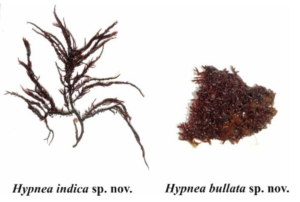In News: Recently, Two new red algal seaweed species, discovered along the coasts of Kanyakumari in Tamil Nadu and in Gujarat and Daman Diu by a group of marine botanists, led by Felix Bast from the Central University of Punjab, Bathinda (CUPB).
About New Red Algal Seaweed

- Hypnea indica was discovered in Kanyakumari in Tamil Nadu, and Somnath Pathan and Sivrajpur in Gujarat.
- Hypnea bullata was discovered from Kanyakumari and Diu island of Daman and Diu.
- It is for the first time we have discovered these red algal species of sea weeds along Indian coasts.
Significance Hypnea
- Hypnea variants of seaweeds can fetch good monetary value if commercial-scale cultivation is taken up.
- Hypnea contains Carrageenan, a biomolecule commonly used in the food industry.
What is Seaweed?
- Seaweeds are also known as Macroalgae.
- Constitute several species of marine plants and algae.
- Seaweeds may also include Red, Green and Brown algae.
- Seaweeds can grow in the ocean, rivers, lakes and other water bodies.
- There are many types of seaweeds such as nori and laver seaweed.
- Seaweeds are attracting interests all around the world for its potential in commercial exploitation and sustainability needs.
Commercial Significance of Seaweeds
- Seaweed is full of vitamins, minerals, & fibre.
- Many seaweeds contain anti-inflammatory & anti-microbial agents.
- They are known to process significant medicinal effects.
- Certain seaweeds possess powerful cancer-fighting agents.
- They are effective binding agents (emulsifiers) & are used as commercial goods as toothpaste & fruit jelly, & popular softeners (emollients) in organic cosmetics & skin-care products.
Seaweed Cultivation Potential in India
- India is among the 12 mega-biodiversity nations in the world.
- India has an Exclusive Economic Zone (EEZ) of 2.17 million km2.
- The Indian coastline, with its different coastal ecosystems, supports luxuriant growth of diverse seaweed populations, having considerable economic importance.
- About 844 seaweed species are reported from India which has a coastline of 7,500 km.
- On the West Coast, especially in Gujarat, abundant resources are present on the intertidal & subtidal regions.
- These resources have great potential for the development of seaweed-based industries in India.
- Tamil Nadu, Gujarat coasts, Lakshadweep & Andaman & Nicobar Islands are abundant in seaweed.
- Rich seaweed beds are also found around Mumbai, Ratnagiri, Goa, Karwar, Varkala, Vizhinjam & Pulicat in Tamil Nadu & Chilka in Orissa.
- Gulf of Mannar is home to more than 240 seaweed varieties out of which at least 185 are edible ones
















